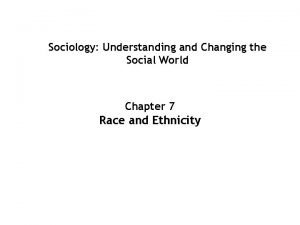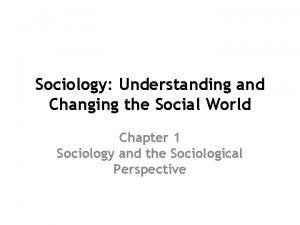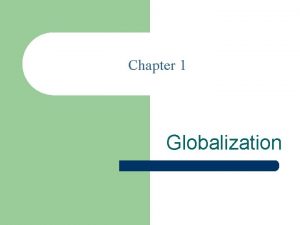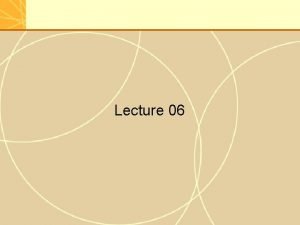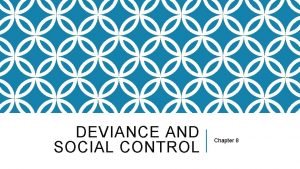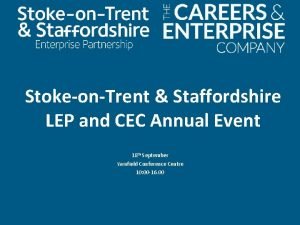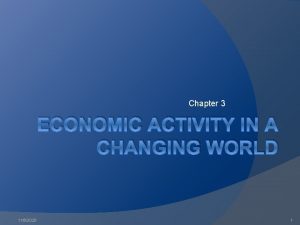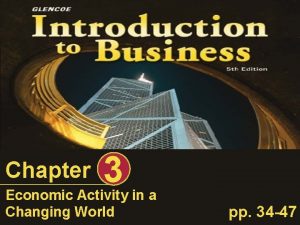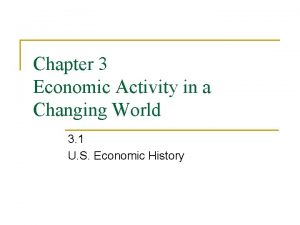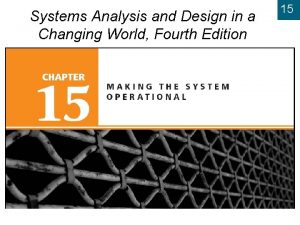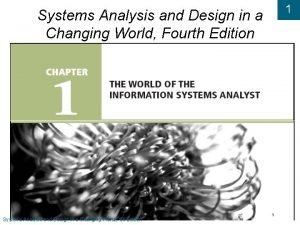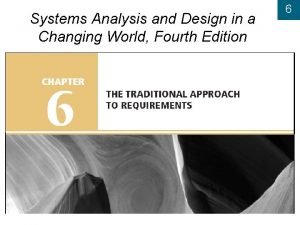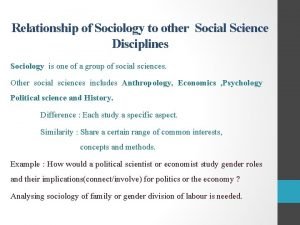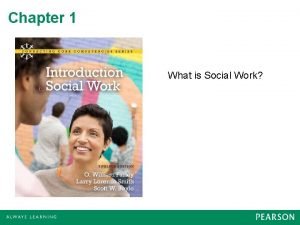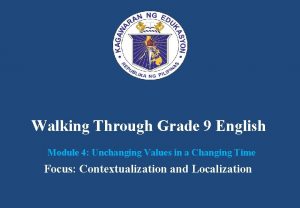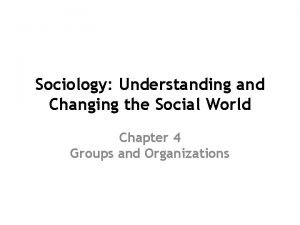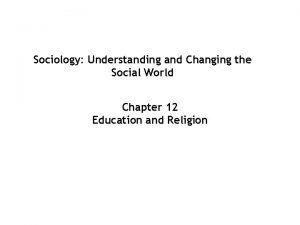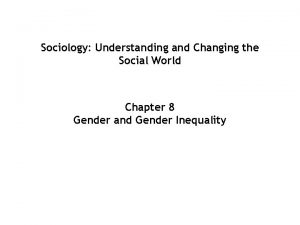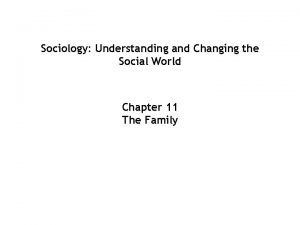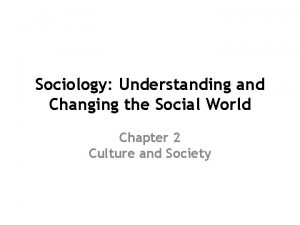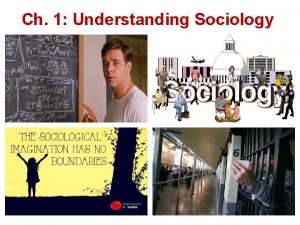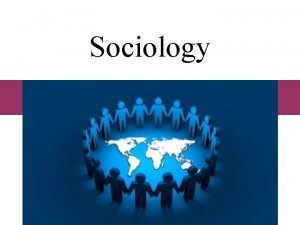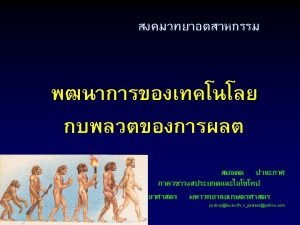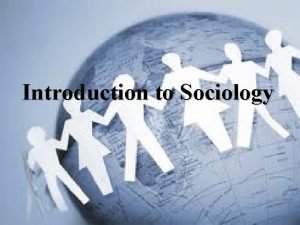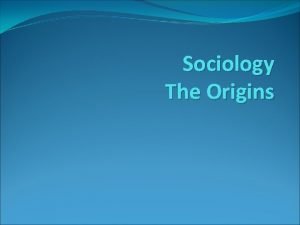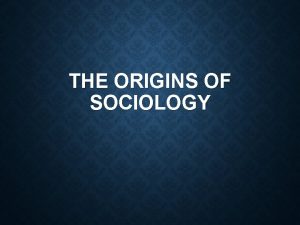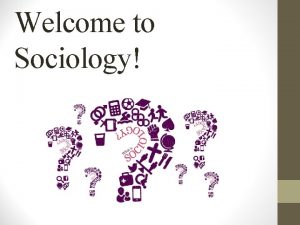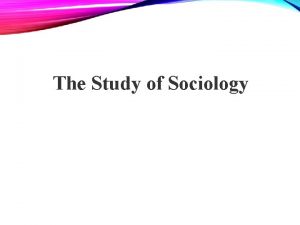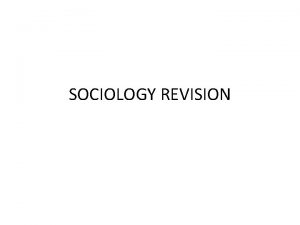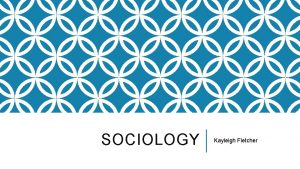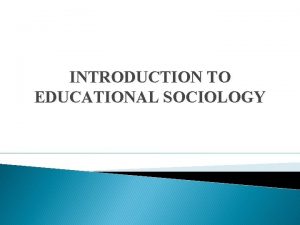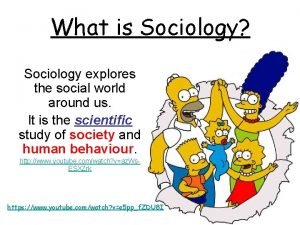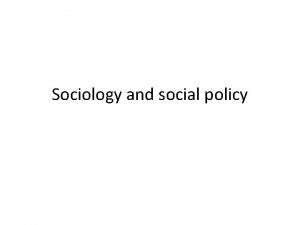Sociology Understanding and Changing the Social World Chapter






















- Slides: 22

Sociology: Understanding and Changing the Social World Chapter 7 Race and Ethnicity 7 -1

Learning Objectives • • • 7 -2 Describe the targets of nineteenth-century mob violence in U. S. cities Discuss why the familiar saying, “the more things change, the more they stay the same, ” applies to the history of race and ethnicity in the United States Critique the biological concept of race Discuss why race is a social construction Discuss the advantages and disadvantages of a sense of ethnic identity Define prejudice, racism, and stereotypes

Learning Objectives • • • 7 -3 Discuss the major social-psychological and sociological theories of prejudice Describe how the nature of prejudice has changed Discuss Merton’s views on whether prejudice and discrimination always coincide Distinguish between individual discrimination and institutional discrimination Provide two examples of institutional discrimination

Learning Objectives • • • 7 -4 Describe three explanations for why racial and ethnic inequality exists in the United States Provide two examples of white privilege Discuss why there is cause for hope and despair in regard to race and ethnic relations in the United States Summarize the debate over affirmative action Summarize recent reaction to growing immigration into the United States

Racial and Ethnic Relations: An American Dilemma • • 7 -5 U. S. history is filled with violence and other maltreatment against Native Americans, Blacks, and immigrants The familiar saying, “the more things change, they more they stay the same, ” applies to race and ethnic relations in the United States

The Meaning of Race • • Race: A category of people who share certain inherited physical characteristics, such as skin color, facial features, and stature Anthropologists, sociologists, and biologists question the value of the biological concept of race: – More physical differences exist within a race than between races – An individual or group of individuals is often “assigned” to a race on arbitrary or even illogical grounds – People from different races are more than 99. 9 percent the same in their DNA 7 -6

The Meaning of Race • Race as a social construction – Social construction: A concept that has no objective reality but rather is what people decide it is – According to social construction, race has no real existence other than what and how people think of it – Race has real consequences because people do perceive race as something real 7 -7

The Meaning of Race • • Ethnicity: The shared social, cultural, and historical experiences, stemming from common national or regional backgrounds, that make subgroups of a population different from one another Ethnic group: A subgroup of a population with: – A set of shared social, cultural, and historical experiences – Relatively distinctive beliefs, values, and behaviors – Some sense of identity of belonging to the subgroup 7 -8

The Meaning of Race • Advantages of ethnicity – It gives individuals a sense of belonging and a recognition of the importance of their cultural backgrounds – It gives individuals ethnic pride • Ethnic pride: The sense of self-worth that many people derive from their ethnic backgrounds – Plays an important role in the socialization of millions of people in the United States and elsewhere in the world • Disadvantages of ethnicity – Creates conflict, prejudice, and hatred among people of different ethnic groups 7 -9

Prejudice • • • 7 -10 Prejudice: A set of negative attitudes, beliefs, and judgments about whole categories of people, and about individual members of those categories, because of their perceived race and/or ethnicity Racism: The belief that certain racial or ethnic groups are inferior to one’s own Stereotypes: Simplified, mistaken generalizations about people because of their race and/or ethnicity

Prejudice • Major social-psychological explanations – Authoritarian personality: A personality emphasizing such things as obedience to authority, a rigid adherence to rules, and low acceptance of people not like oneself and said to help account for racial and ethnic prejudice – Frustration or scapegoat theory: As an explanation of racial and ethnic prejudice, the view that individuals blame the problems they experience on racial and ethnic minorities and thus scapegoat them instead of recognizing the real sources of their own misfortunes 7 -11

Prejudice • Major sociological explanations – Conformity and socialization (Social learning theory) — People who are prejudiced are merely conforming to the culture in which they grew up, and prejudice is the result of socialization from parents, peers, the news media, and other various aspects of their culture – Economic and political competition (Group threat theory) — Prejudice arises from competition over jobs and other resources and from disagreement over various political issues • 7 -12 Discrimination: It is the arbitrary denial of rights, privileges, and opportunities to members of subordinate racial and ethnic groups

Table 7. 1 - The Relationship between Prejudice and Discrimination 7 -13

Discrimination Individual discrimination • Individuals practice in their daily lives Institutional discrimination • The practices of whole institutions, such as housing, medical care, law enforcement, employment, and education, even if such discrimination is not intended 7 -14

Discrimination • 7 -15 Examples of institutional discrimination – Health discrimination – Employment discrimination

Racial and Ethnic Inequality in the United States • • Why does racial and ethnic inequality exist in the U. S? Some of the explanations are: – Blacks and other people of color are biologically inferior • They are naturally less intelligent and have other innate flaws that keep them from getting a good education and otherwise doing what needs to be done to achieve the American dream – Due to cultural deficiencies, which include a failure to value hard work and a lack of strong family ties, are said to account for the poverty and other problems facing these minorities – Due to institutional and individual discrimination and a lack of opportunity in education and other spheres of life 7 -16

Racial and Ethnic Inequality in the United States • White privilege: The advantages that U. S. whites enjoy in their daily lives simply because they are white, whether or not they are aware of these advantages – Examples: • Whites can drive a car at night or walk down a street without having to fear that a police officer will stop them • College students who are white can live in dorms without having to worry that racial slurs will be directed their way 7 -17

Race and Ethnicity in the Twenty-First Century • There is cause for hope – Legal segregation is gone – People of color have made important gains in several spheres of life – African Americans and other people of color occupy some important elected positions 7 -18

Race and Ethnicity in the Twenty-First Century • There is cause for despair – The old-fashioned racism has been replaced by a modern, symbolic racism, that still blames people of color for their problems and reduces public support for government policies to deal with their problems – Institutional discrimination remains pervasive – Hate crimes remain all too common – Americans of different racial and ethnic backgrounds remain sharply divided on many issues – Two issues that continue to arouse controversy — Affirmative action and immigration 7 -19

Race and Ethnicity in the Twenty-First Century • • Affirmative action: It is the preferential treatment of minorities and women in employment and education Opponents of affirmative action cite several reasons for opposing it: – Affirmative action is reverse discrimination — Illegal and immoral – The people benefiting from affirmative action are less qualified than many of the whites with whom they are competing for employment and college admissions – It implies that the people benefiting from it need extra help and thus are indeed less qualified 7 -20

Race and Ethnicity in the Twenty-First Century • Proponents of affirmative action give several reasons for favoring it: – It is needed to make up not just for past discrimination and lack of opportunities for people of color, but also for ongoing discrimination and lack of opportunity – Affirmative action helps add diversity to the workplace and to the campus – Affirmative action has succeeded in expanding employment and educational opportunities for people of color – Individuals benefiting from affirmative action have generally fared well in the workplace or on the campus 7 -21

Race and Ethnicity in the Twenty-First Century • • • 7 -22 A cautious view — Affirmative action may not be perfect, but that some form of it is needed to make up for past and ongoing discrimination and lack of opportunity in the workplace and on the campus Without the help that affirmative action programs give disadvantaged people of color, the discrimination and other difficulties they face are certain to continue Recent immigration trends have increased anti-immigration prejudice, including hate crimes, in the United States
 Sociology understanding and changing the social world
Sociology understanding and changing the social world Debunking motif definition
Debunking motif definition The changing world output and world trade picture
The changing world output and world trade picture The changing world output and world trade picture
The changing world output and world trade picture Primary deviance definition
Primary deviance definition Carl ward city learning trust
Carl ward city learning trust Chapter 3 economic activity in a changing world answer key
Chapter 3 economic activity in a changing world answer key Chapter 3 economic activity in a changing world
Chapter 3 economic activity in a changing world Chapter 3 economic activity in a changing world
Chapter 3 economic activity in a changing world Chapter 3 economic activity in a changing world
Chapter 3 economic activity in a changing world System analysis and design
System analysis and design Systems analysis and design in a changing world
Systems analysis and design in a changing world System analysis and design in a changing world
System analysis and design in a changing world Systems analysis and design in a changing world
Systems analysis and design in a changing world Systems analysis and design in a changing world
Systems analysis and design in a changing world Systems analysis and design in a changing world
Systems analysis and design in a changing world Systems analysis and design in a changing world
Systems analysis and design in a changing world Systems analysis and design in a changing world
Systems analysis and design in a changing world Systems analysis and design in a changing world
Systems analysis and design in a changing world Sociology and social science
Sociology and social science Distinguishing characteristics of social work
Distinguishing characteristics of social work World changing glasgow
World changing glasgow Grade 10 english module 4 pre test answer key
Grade 10 english module 4 pre test answer key
